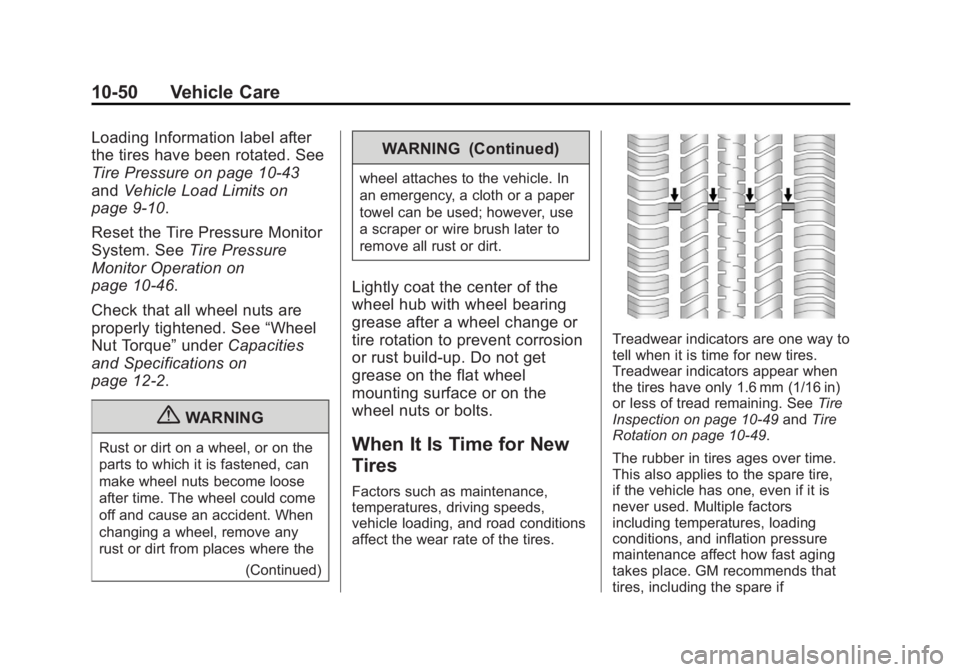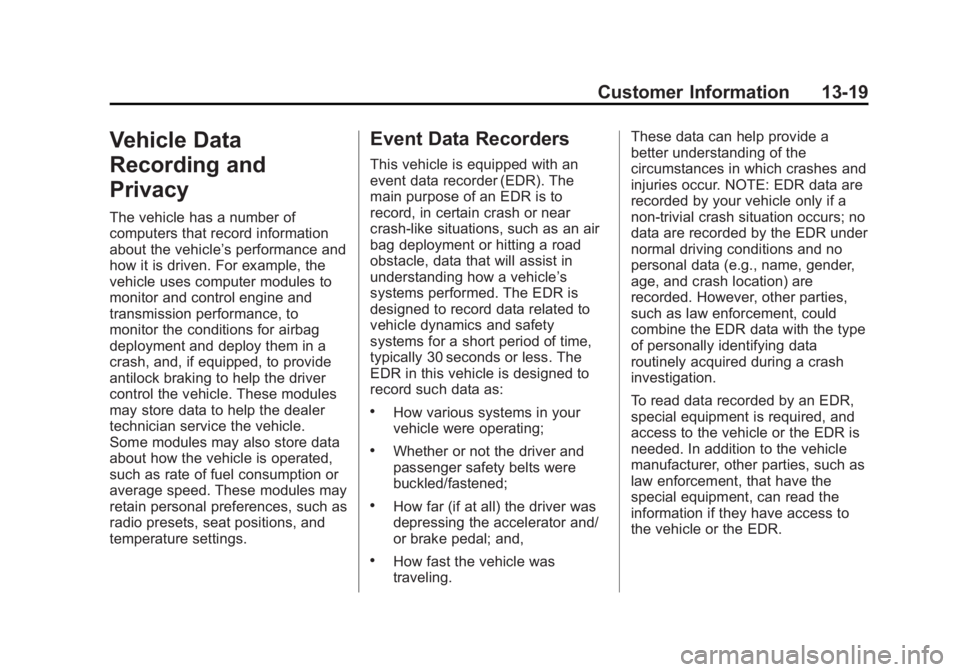2013 CHEVROLET CAPTIVA SPORT reset
[x] Cancel search: resetPage 245 of 374

Black plate (11,1)Chevrolet Captiva Sport Owner Manual - 2013 - crc - 11/12/12
Vehicle Care 10-11since the last oil change.
Remember to reset the oil life
system whenever the oil is changed.
How to Reset the Engine Oil
Life System Reset the system whenever the
engine oil is changed so that the
system can calculate the next
engine oil change. To reset the
system:
1. Press the DIC vehicle
information button to display OIL
LIFE REMAINING on the DIC.
See Driver Information Center
(DIC) on page 5 ‑ 23 and Engine
Oil Messages on page 5 ‑ 30 .
2. Press the DIC Set/Reset button
for five seconds to reset the oil
life at 100%.
Be careful not to reset the oil life
display accidentally at any time
other than after the oil is
changed. It cannot be reset
accurately until the next oil
change. The oil life system can also be reset
as follows:
1. Turn the ignition key to ON/RUN
with the engine off.
2. Fully press and release the
accelerator pedal three times
within five seconds.
If the OIL LIFE REMAINING value is
not 100%, the system needs to be
reset again.
Automatic Transmission
Fluid It is not necessary to check the
transmission fluid level.
A transmission fluid leak is the only
reason for fluid loss. If a leak
occurs, take the vehicle to the
dealer and have it repaired as soon
as possible.
Change the fluid and filter at the
intervals listed in Maintenance
Schedule on page 11 ‑ 3 , and be sure
to use the transmission fluid listed in
Recommended Fluids and
Lubricants on page 11 ‑ 12 . Notice: Use of the incorrect
automatic transmission fluid may
damage the vehicle, and the
damages may not be covered by
the vehicle warranty. Always use
the automatic transmission fluid
listed in Recommended Fluids
and Lubricants on page 11 ‑ 12 .
For the 2.4L L4 and 3.0L
V6 engines, the transmission fluid
will not reach the end of the dipstick
unless the transmission is at
operating temperature. If you need
to check the transmission fluid level,
please take the vehicle to your
dealer.
Engine Air Cleaner/Filter See Engine Compartment Overview
on page 10 ‑ 4 for the location of the
engine air cleaner/filter.
Page 260 of 374

Black plate (26,1)Chevrolet Captiva Sport Owner Manual - 2013 - crc - 11/12/12
10-26 Vehicle Care 2. Turn the bottom edge of the
blade assembly (2) slightly away
from the underside of the
wiper arm.
3. Apply downward pressure to the
blade assembly and remove
from the wiper arm.
4. Install the new wiper blade.
5. Return the wiper arm and blade
assembly to the rest position on
the window.
Headlamp Aiming Headlamp aim has been preset and
should need no further adjustment.
If the vehicle is damaged in a crash,
the headlamp aim may be affected.
If adjustment to the headlamps is
necessary, see your dealer.
Bulb Replacement For the proper type of replacement
bulbs, see Replacement Bulbs on
page 10 ‑ 29 .
For any bulb ‐ changing procedure
not listed in this section, contact
your dealer.
Halogen Bulbs
{ WARNINGHalogen bulbs have pressurized
gas inside and can burst if you
drop or scratch the bulb. You or
others could be injured. Be sure
to read and follow the instructions
on the bulb package.
Headlamps To replace one of the headlamp
bulbs, use the following procedure.
To replace the parking/turn signal
lamp bulb, see Front Turn Signal
and Parking Lamps on page 10 ‑ 27 .
Page 284 of 374

Black plate (50,1)Chevrolet Captiva Sport Owner Manual - 2013 - crc - 11/12/12
10-50 Vehicle Care Loading Information label after
the tires have been rotated. See
Tire Pressure on page 10 ‑ 43
and Vehicle Load Limits on
page 9 ‑ 10 .
Reset the Tire Pressure Monitor
System. See Tire Pressure
Monitor Operation on
page 10 ‑ 46 .
Check that all wheel nuts are
properly tightened. See “ Wheel
Nut Torque ” under Capacities
and Specifications on
page 12 ‑ 2 .
{ WARNING
Rust or dirt on a wheel, or on the
parts to which it is fastened, can
make wheel nuts become loose
after time. The wheel could come
off and cause an accident. When
changing a wheel, remove any
rust or dirt from places where the
(Continued) WARNING (Continued) wheel attaches to the vehicle. In
an emergency, a cloth or a paper
towel can be used; however, use
a scraper or wire brush later to
remove all rust or dirt.
Lightly coat the center of the
wheel hub with wheel bearing
grease after a wheel change or
tire rotation to prevent corrosion
or rust build-up. Do not get
grease on the flat wheel
mounting surface or on the
wheel nuts or bolts.
When It Is Time for New
Tires Factors such as maintenance,
temperatures, driving speeds,
vehicle loading, and road conditions
affect the wear rate of the tires. Treadwear indicators are one way to
tell when it is time for new tires.
Treadwear indicators appear when
the tires have only 1.6 mm (1/16 in)
or less of tread remaining. See Tire
Inspection on page 10 ‑ 49 and Tire
Rotation on page 10 ‑ 49 .
The rubber in tires ages over time.
This also applies to the spare tire,
if the vehicle has one, even if it is
never used. Multiple factors
including temperatures, loading
conditions, and inflation pressure
maintenance affect how fast aging
takes place. GM recommends that
tires, including the spare if
Page 317 of 374

Black plate (3,1)Chevrolet Captiva Sport Owner Manual - 2013 - crc - 11/12/12
Service and Maintenance 11-3
Maintenance
Schedule Owner Checks and Services At Each Fuel Stop .
Check the engine oil level. See
Engine Oil on page 10 ‑ 8 .
Once a Month .
Check the tire inflation
pressures. See Tire Pressure on
page 10 ‑ 43 ..
Inspect the tires for wear. See
Tire Inspection on page 10 ‑ 49 ..
Check the windshield washer
fluid level. See Washer Fluid on
page 10 ‑ 20 . Engine Oil Change When the CHANGE ENGINE OIL
SOON message displays, have the
engine oil and filter changed within
the next 1 000 km/600 mi. When the
CHANGE ENGINE OIL NOW
message displays, have the engine
oil and filter changed as soon as
possible. If driven under the best
conditions, the engine oil life system
might not indicate the need for
vehicle service for more than a year.
The engine oil and filter must be
changed at least once a year and
the oil life system must be reset.
Your trained dealer technician can
perform this work. If the engine oil
life system is reset accidentally,
service the vehicle within 5 000 km/
3,000 mi since the last service.
Reset the oil life system when the
oil is changed. See Engine Oil Life
System on page 10 ‑ 10 . Tire Rotation and Required
Services Every 12 000 km/
7,500 mi Rotate the tires, if recommended for
the vehicle, and perform the
following services. See Tire
Rotation on page 10 ‑ 49 . .
Check engine oil level and oil
life percentage. If needed,
change engine oil and filter, and
reset oil life system. See Engine
Oil on page 10 ‑ 8 and Engine Oil
Life System on page 10 ‑ 10 . .
Check engine coolant level. See
Engine Coolant on page 10 ‑ 14 . .
Check windshield washer fluid
level. See Washer Fluid on
page 10 ‑ 20 . .
Visually inspect windshield wiper
blades for wear, cracking,
or contamination. See Exterior
Care on page 10 ‑ 72 . Replace
worn or damaged wiper blades.
See Wiper Blade Replacement
on page 10 ‑ 25 .
Page 353 of 374

Black plate (19,1)Chevrolet Captiva Sport Owner Manual - 2013 - crc - 11/12/12
Customer Information 13-19
Vehicle Data
Recording and
Privacy The vehicle has a number of
computers that record information
about the vehicle ’ s performance and
how it is driven. For example, the
vehicle uses computer modules to
monitor and control engine and
transmission performance, to
monitor the conditions for airbag
deployment and deploy them in a
crash, and, if equipped, to provide
antilock braking to help the driver
control the vehicle. These modules
may store data to help the dealer
technician service the vehicle.
Some modules may also store data
about how the vehicle is operated,
such as rate of fuel consumption or
average speed. These modules may
retain personal preferences, such as
radio presets, seat positions, and
temperature settings. Event Data Recorders This vehicle is equipped with an
event data recorder (EDR). The
main purpose of an EDR is to
record, in certain crash or near
crash-like situations, such as an air
bag deployment or hitting a road
obstacle, data that will assist in
understanding how a vehicle ’ s
systems performed. The EDR is
designed to record data related to
vehicle dynamics and safety
systems for a short period of time,
typically 30 seconds or less. The
EDR in this vehicle is designed to
record such data as: .
How various systems in your
vehicle were operating; .
Whether or not the driver and
passenger safety belts were
buckled/fastened; .
How far (if at all) the driver was
depressing the accelerator and/
or brake pedal; and, .
How fast the vehicle was
traveling. These data can help provide a
better understanding of the
circumstances in which crashes and
injuries occur. NOTE: EDR data are
recorded by your vehicle only if a
non-trivial crash situation occurs; no
data are recorded by the EDR under
normal driving conditions and no
personal data (e.g., name, gender,
age, and crash location) are
recorded. However, other parties,
such as law enforcement, could
combine the EDR data with the type
of personally identifying data
routinely acquired during a crash
investigation.
To read data recorded by an EDR,
special equipment is required, and
access to the vehicle or the EDR is
needed. In addition to the vehicle
manufacturer, other parties, such as
law enforcement, that have the
special equipment, can read the
information if they have access to
the vehicle or the EDR.